|
|
| |
|
|
| |
|
|
|
|
| |
 |
| A backgammon set,
consisting of a board, two sets of 15 checkers,
two pairs of dice, a doubling cube, and dice
cups. |
Backgammon
Backgammon is a game played by two players. Each player
moves pieces around a board. Players roll two dice to
find out how far their pieces can move in one turn. The
winner of one game is the first to get all pieces all
the way around, and off, the board.
The game is laid-out asymmetrically. White's direction
of travel is counter-clockwise, whereas black's
direction of travel is clockwise. (There is no advantage
to either side due to this asymmetry.)
White moves from white's far right to white's home area
on white's close right, in the shape of a right-hand "C"
from white's point of view. Black moves along the same
"C", beginning from black's far left and ending at
black's home area on black's close left. (The "C" is the
same for both sides - the "C" points to the right for
white and points to the left for black.) |
|
|
Some pieces (for each side) begin already in the home
quadrant, and some pieces must make their way all the
way around. Pieces can be sent backwards to their
starting position during play. |
|
The roll of two dice introduces a random component in
the game, but Backgammon is basically a game of
strategy.
Usual playing time is around 15– 30 minutes, for a
single game (which could be thought of as something like
one particular long "hand" of a card game). An overall
championship or round of backgammon involves a number of
ongoing single games, with the involvement of points, a
"doubling cube," and other complications. |
|
|
The game has a long history. Games that resemble it have
been played for thousands of years. Archaeologists doing
excavations at a place called Burnt City in modern-day
Iran have found parts of a game that resembled
backgammon. They have found 60 pieces to play with, and
two dice. They could show that the game utensils date
from around 3000 BC. These pieces around 100–200 years
older than another set, found in Ur, in Mesopotamia. |
|
|
 Kiddle: Backgammon Kiddle: Backgammon
Wikipedia: Backgammon |
|
|
|
|
|
|
|
|
|
|
|
|
|
|
|
|
Search Fun Easy English |
|
|
|
|
|
|
|
|
|
|
|
|
|
|
|
About
Contact
Copyright
Resources
Site Map |